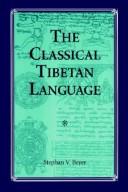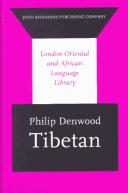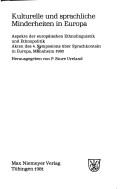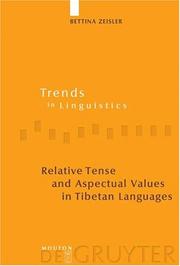| Listing 1 - 10 of 12 | << page >> |
Sort by
|

ISBN: 0585086907 9780585086903 0791410994 0791411001 9780791410998 9780791411001 9780791496695 0791496694 Year: 1992 Publisher: Albany State University of New York Press
Abstract | Keywords | Export | Availability | Bookmark
 Loading...
Loading...Choose an application
- Reference Manager
- EndNote
- RefWorks (Direct export to RefWorks)
Tibetan language. --- Bhotanta language --- Tibeto-Burman languages
Book
ISBN: 1844644138 9781844644131 9781844644124 184464412X Year: 2017 Publisher: Reading
Abstract | Keywords | Export | Availability | Bookmark
 Loading...
Loading...Choose an application
- Reference Manager
- EndNote
- RefWorks (Direct export to RefWorks)
Tibetan language --- Bhotanta language --- Tibeto-Burman languages --- Writing. --- Alphabet.

ISBN: 0791411001 0791410994 9780791411001 Year: 1992 Publisher: Albany (N.Y.): State university of New York press,
Abstract | Keywords | Export | Availability | Bookmark
 Loading...
Loading...Choose an application
- Reference Manager
- EndNote
- RefWorks (Direct export to RefWorks)
Tibetan language. --- S24/0400 --- #SML: Paul Serruys --- Tibet--Language --- Tibetan language --- Bhotanta language --- Tibeto-Burman languages

ISBN: 9027238030 1556197276 9786613222428 1283222426 9027283060 9789027283061 9781556197277 9789027238030 Year: 1999 Volume: 3 Publisher: Amsterdam : Benjamins,
Abstract | Keywords | Export | Availability | Bookmark
 Loading...
Loading...Choose an application
- Reference Manager
- EndNote
- RefWorks (Direct export to RefWorks)
The Tibetan language comprises a wide range of spoken and written varieties whose known history dates from the 7th century AD to the present day. Its speakers inhabit a vast area in Central Asia and the Himalayas extending into seven modern nation states, while its abundant literature includes much of vital importance to the study of Buddhism. After surveying all the known varieties of Tibetan, including their geographical and historical background, this book concentrates on a phonological and grammatical description of the modern spoken Lhasa dialect, the standard spoken variety.
Tibetan language --- Dialects --- Grammar. --- Sino-Tibetan languages --- Tibétain (Langue) --- Grammaire --- Dialectes --- Bhotanta language --- Tibeto-Burman languages
Book
ISBN: 9789004300996 9789004301153 9004301151 9004300996 Year: 2015 Publisher: Leiden ; Boston Brill
Abstract | Keywords | Export | Availability | Bookmark
 Loading...
Loading...Choose an application
- Reference Manager
- EndNote
- RefWorks (Direct export to RefWorks)
The papers in Tibetan Literary Genres, Texts, and Text Types deepen our knowledge of Tibetan literature. They not only examine particular Tibetan genres and texts (pre-modern and contemporary), but also genre classification, transformation, and reception. Despite previous contributions, the systematic analysis of Tibetan textual genres is still a relatively undeveloped field, especially when compared with the sophisticated examinations of other literary traditions. The book is divided into four parts: textual typologies, blurred genre boundaries, specific texts and text types, and genres in transition to modernity. The introduction discusses previous classificatory approaches and concepts of textual linguistics. The text classes that receive individual attention can be summarised as songs and poetry, offering-ritual, hagiography, encyclopaedia, lexicographical texts, trickster narratives, and modern literature. Contributors include: Franz-Karl Ehrhard, Ruth Gamble, Lama Jabb, Roger R. Jackson, Giacomella Orofino, Jim Rheingans, Peter Schwieger, Ekaterina Sobkovyak, Victoria Sujata, and Peter Verhagen.
Tibetan literature --- Buddhist literature, Tibetan. --- Tibetan language. --- Bhotanta language --- Tibeto-Burman languages --- Tibetan Buddhist literature --- History and criticism.
Book
ISBN: 9004251227 9789004251229 9789004251182 9004251189 Year: 2014 Publisher: Boston, MA : Global Oriental,
Abstract | Keywords | Export | Availability | Bookmark
 Loading...
Loading...Choose an application
- Reference Manager
- EndNote
- RefWorks (Direct export to RefWorks)
Based on the Tibetan loanwords in an archaic Mongolic language, the author reconstructed an unknown Tibetan dialect which pertains to the North Eastern Archaic Tibetan group. The result is compared with the data known from other NEAT dialects, with the material of the West Archaic Tibetan languages such as Balti, Purig and Ladak, and also with the non-archaic dialects from Central Tibet and Lhasa. With the use of Literary Tibetan and data from Old Tibetan, Tibeto-Mongolica proposes a new approach to the reconstruction of the history of the Tibetan language. Originally published in 1966, and long out of print, the book has served as a standard handbook for historical Tibetan studies for several generations of scholars and is now updated by a new Introduction and enhanced by reprints of a selection of the author’s relevant Tibetological papers.
Mongour language --- Tibetan language --- Mongghul language --- Monguor language --- Tu language --- Mongolian languages --- Foreign words and phrases --- Tibetan. --- Dialects. --- Tibetan language. --- Bhotanta language --- Tibeto-Burman languages
Book
ISBN: 1108601456 1316550931 1107146488 1108575625 Year: 2019 Publisher: Cambridge : Cambridge University Press,
Abstract | Keywords | Export | Availability | Bookmark
 Loading...
Loading...Choose an application
- Reference Manager
- EndNote
- RefWorks (Direct export to RefWorks)
The discovery of sound laws by comparing attested languages is the method which has unlocked the history of European languages stretching back thousands of years before the appearance of written records, e.g. Latin p- corresponds to English f- (pes, foot; primus, first; plenus, full). Although Burmese, Chinese, and Tibetan have long been regarded as related, the systematic exploration of their shared history has never before been attempted. Tracing the history of these three languages using just such sound laws, this book sheds light on the prehistoric language from which they descend. Written for readers with little linguistic knowledge of these languages, but fully explicit and copiously indexed for the specialist, this work will serve as the bedrock for future progress in the study of these languages.
Tibetan language --- Burmese language --- Chinese language --- Tibeto-Burman languages --- Sino-Tibetan languages --- Bhotanta language --- Himalayan languages --- Chin languages --- Burman language --- Phonology --- History. --- Phonology, Comparative --- Chinese. --- Tibeto-Burman.

ISBN: 3484301082 3111357104 Year: 1981 Publisher: Tübingen
Abstract | Keywords | Export | Availability | Bookmark
 Loading...
Loading...Choose an application
- Reference Manager
- EndNote
- RefWorks (Direct export to RefWorks)
Paraphrasenbeziehungen Zwischen Disjunktiven Und Konjunktiven S Tzen.
-Tibetan language --- -Bhotanta language --- Tibeto-Burman languages --- Coordinate constructions --- -Tibetan --- Tibetan language --- Tibetan. --- -Coordinate constructions --- Grammar --- German language --- Coordinate constructions. --- Grammar, Comparative --- Semantics. --- German. --- Bhotanta language --- Ashkenazic German language --- Hochdeutsch --- Judaeo-German language (German) --- Judendeutsch language --- Judeo-German language (German) --- Jüdisch-Deutsch language --- Jüdischdeutsch language --- Grammar, Comparative&delete& --- Tibetan --- Semantics --- German --- Germanic languages

ISBN: 3110178680 3110908182 Year: 2004 Volume: 150 Publisher: Berlin Mouton de Gruyter
Abstract | Keywords | Export | Availability | Bookmark
 Loading...
Loading...Choose an application
- Reference Manager
- EndNote
- RefWorks (Direct export to RefWorks)
This study presents a comparative approach to a universal theory of TENSE, ASPECT and MOOD, combining the methods of comparative and historical linguistics, fieldwork, text linguistics, and philology. The parts of the book discuss and describe (i) the concepts of TENSE, ASPECT and MOOD; (ii) the Tibetan system of RELATIVE TENSE and aspectual values, with main sections on Old and Classical Tibetan, "Lhasa" Tibetan, and East Tibetan (Amdo and Kham); and (iii) West Tibetan (Ladakhi, Purik, Balti); Part (iv) presents the comparative view. Discussing the similarities and differences of temporal and aspectual concepts, the study rejects the general claim that ASPECT is a linguistic universal. A new linguistic concept, FRAMING, is introduced in order to account for the aspect-like conceptualisations found in, e.g., English. The concept of RELATIVE TENSE or taxis, may likewise not be universal. Among the Tibetan varieties, West Tibetan is unique in having fully grammaticalized the concept of ABSOLUTE TENSE. West Tibetan is compared diachronically with Old and Classical Tibetan (documented since the mid 8th century) and synchronically with several contemporary Tibetan varieties. The grammaticalized forms of each variety are described on the basis of their employment in discourse. The underlying general function of the Tibetan verbal system is thus shown to be that of RELATIVE TENSE. Secondary aspectual functions are described for restricted contexts. A special focus on the pragmatic or metaphorical use of present tense constructions in Tibetan leads to a typology of narrative conventions. The last part also offers some suggestions for the reconstruction of the Proto-Tibetan verb system.
Sino-Tibetan languages --- Comparative linguistics --- Grammar --- Tibetan language --- Tibétain (Langue) --- Tense. --- Aspect. --- Temps --- Aspect --- 801.56 --- Syntaxis. Semantiek --- 801.56 Syntaxis. Semantiek --- Tibétain (Langue) --- Bhotanta language --- Tibeto-Burman languages --- Language Typology. --- Tibet /Language.
Book
ISBN: 9048552710 9463725040 Year: 2022 Publisher: Amsterdam : Amsterdam University Press,
Abstract | Keywords | Export | Availability | Bookmark
 Loading...
Loading...Choose an application
- Reference Manager
- EndNote
- RefWorks (Direct export to RefWorks)
Bordering Tibetan Languages: Making and Marking Languages in Transnational High Asia examines the complex interactions between state, ethnic, and linguistic borders in the Himalaya. These case studies from Bhutan, China, India, and Nepal show how people in the Himalaya talk borders into existence, and also how those borders speak to them and their identities. These 'talking borders' exist in a world where state borders are contested, and which is being irrevocably transformed by rapid social and economic change. This book offers a new perspective on this dynamic region by centring language, and in doing so, also offers new ways of thinking about how borders and language influence each other.
Borderlands --- Group identity --- Tibetan language --- Bhotanta language --- Tibeto-Burman languages --- Collective identity --- Community identity --- Cultural identity --- Social identity --- Identity (Psychology) --- Social psychology --- Collective memory --- Border-lands --- Border regions --- Frontiers --- Boundaries --- Social aspects --- Himalaya, linguistic anthropology, borders, Tibet. --- Dialects. --- Social aspects.
| Listing 1 - 10 of 12 | << page >> |
Sort by
|

 Search
Search Feedback
Feedback About UniCat
About UniCat  Help
Help News
News